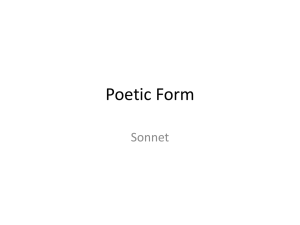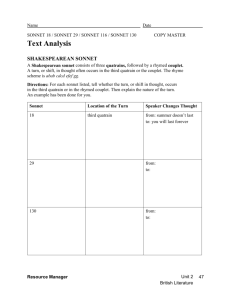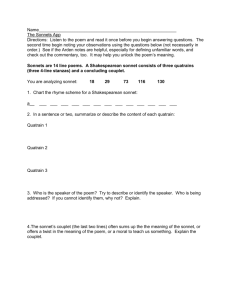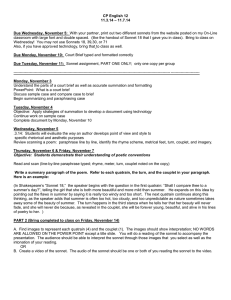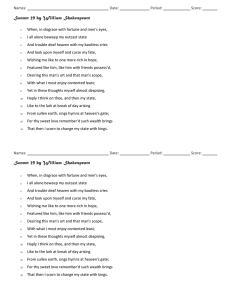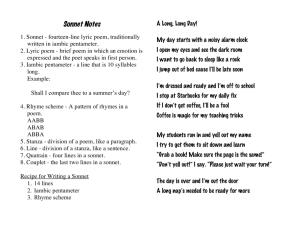Shakespearean Sonnet
advertisement
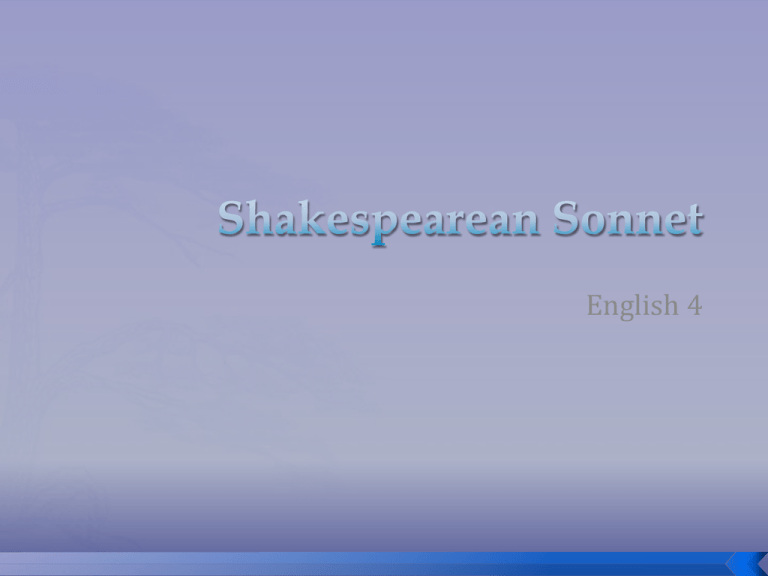
English 4 Do Now “Love looks not with the eyes, but with the mind” • Do you agree or disagree with this statement? • Explain your reasoning using specific examples. http://youtu.be/YGaqlO9bClk • Born in Stratford-upon-Avon • Many mysteries surround his life • Began as an actor and playwright in 1590 in London • Most successful playwright of his time • 37 plays and a collection of sonnets Shakespearean Sonnet Structure • “English” Sonnet -14 lines total • 3 Quatrains -4 line stanza • 1 couplet -Two rhymed lines -Last two lines of the poem • Volta -The turn or shift in thought -Occurs in the third quatrain or couplet • Rhyme Scheme abab cdcd efef gg Quatrain Each addresses the main idea, thought or question Couplet Provides an answer or summation Shakespeare's Sonnets • Master of the English sonnet • Subject of many sonnets is a “dark lady” with human defects • Focused on themes of time, change, and death • • • • Vivid descriptive language that appeals to one or more of the senses (sight, hearing, touch, smell, and taste). Used to create a mental or sensational image in the mind of the reader. Telling: The sun shone on my face. Showing: The sunshine burst through the window to gently shine on my face Sonnet 130 William Shakespeare 4 8 12 My mistress’ eyes are nothing like the sun; Coral is far more red than her lips’ red; If snow be white, why then her breasts are dun; If hairs be wires, black wires grow on her head. I have seen roses damask’d, red and white, But no such roses see I in her cheeks, And in some perfumes is there more delight Than in the breath that from my mistress reeks. I love to hear her speak, yet well I know That music hath a far more pleasing sound; I grant I never saw a goddess go, My mistress when she walks treads on the ground. And yet, by heaven, I think my love as rare As any she belied with false compare. Sonnet 29 William Shakespeare 4 8 12 When in disgrace with Fortune and men’s eyes I all alone beweep my outcast state, And trouble deaf heaven with my bootless cries, And look upon myself and curse my fate, Wishing me like to one more rich in hope, Featur’d like him, like him with friends possess’d, Desiring this man’s art, and that man’s scope, With what I most enjoy contented least; Yet in these thoughts myself despising, Haply I think on thee, and then my state, Like to the lark at break of day arising From sullen earth, sings hymns at heaven’s gate, For thy sweet love rememb’red such wealth brings, That then I scorn to change my state with kings. • Choose Sonnet 130 OR Sonnet 29 by Shakespeare • Illustrate the poem on construction paper • Focus on significant words, phrases, and images • • Find pictures in magazines or draw images to represent the poem Include captions to your visuals -Quote the poem 1. a. b. c. The Shakespearean sonnet is also called the: Italian Sonnet English Sonnet The British Sonnet 2. A sonnet is a poem consisting of how many lines? a. 12 b. 8 c. 14 3. A quatrain is a a. 4 line stanza b. 2 line stanza c. 6 line stanza 4. A couplet is a a. pair of rhyming lines b. group of rhyming lines c. stanza of rhyming lines 5. a. b. c. A Shakespearean sonnet is divided into 4 quatrains and 1 couplet 3 quatrain and 1 couplet 3 quatrains and 2 couplets 6. a. b. c. The turn or shift in thought found in a Shakespearean sonnet is called Volvo Volva Volta 7. Creating a mental or sensational image in the mind of the reader is called a. Imagery b. Metaphor c. Poetry 8. The quatrains in a Shakespearean sonnet are meant to a. Introduce the main idea of the poem b. Provide a solution or summation c. Introduce the speaker of the poem 9. a. b. c. The couplet in a Shakespearean sonnet is meant to Introduce the main idea of the poem Provide a solution or summation Introduce the speaker of the poem 10. Where does the volta occur in Sonnet 130? a. The last quatrain b. The first quatrain c. The couplet 1 thing you learned today 1 thing you still have a question about
